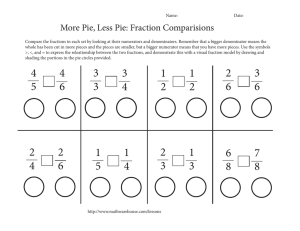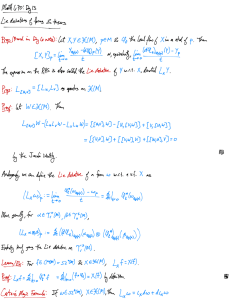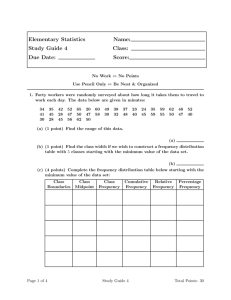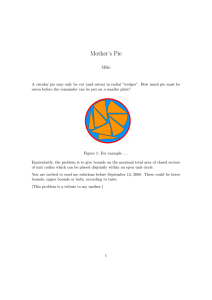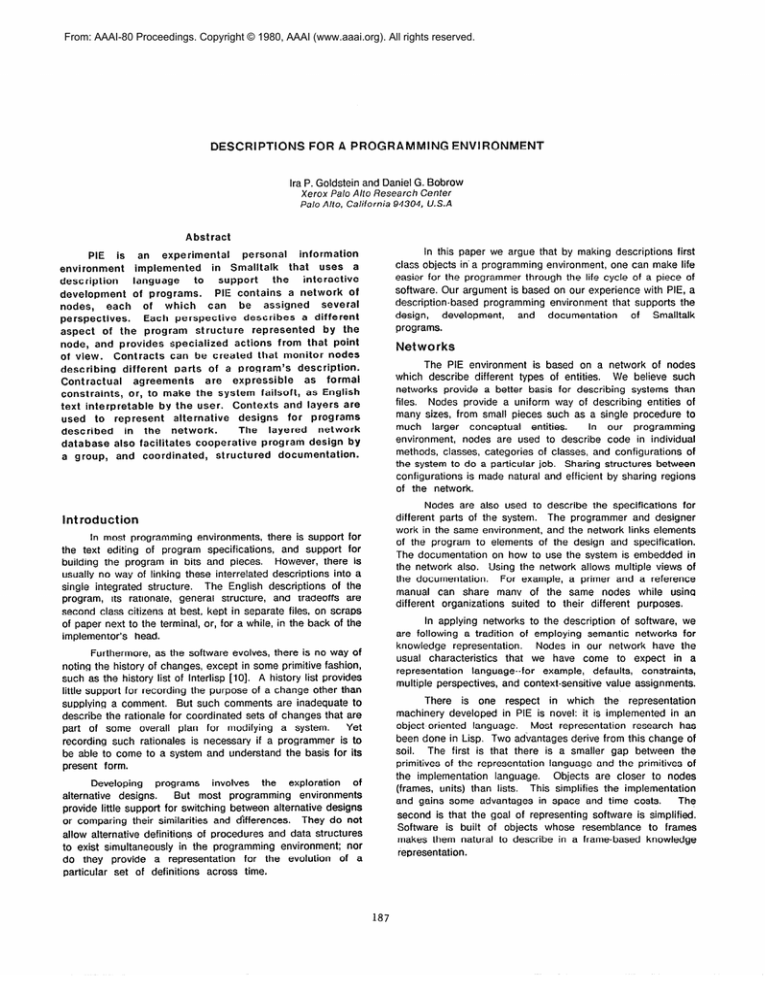
From: AAAI-80 Proceedings. Copyright © 1980, AAAI (www.aaai.org). All rights reserved.
DESCRIPTIONS
FOR A PROGRAMMING
ENVIRONMENT
Ira P. Goldstein and Daniel G. Bobrow
Xerox Palo Alto Research
Center
Palo Alto, California
94304, U.S.A
Abstract
In this paper we argue that by making descriptions first
class objects in’s programming environment, one can make life
easier for the programmer through the life cycle of a piece of
software. Our argument is based on our experience with PIE, a
description-based
programming environment that supports the
design,
development,
and
documentation
of
Smalltalk
programs.
information
experimental
personal
PIE
is an
environment
implemented
in Smalltalk
that
uses a
the
interactive
support
language
to
description
PIE contains a network of
development
of programs.
each
of which
can
be
assigned
several
nodes,
Each perspective
describes
a different
perspectives.
aspect of the program
structure
represented
by the
node, and provides specialized
actions from that point
Contracts
can be created that monitor nodes
of view.
describing
different
parts of a program’s
description.
Contractual
agreements
are
expressible
as formal
constraints,
or, to make the system failsoft, as English
text interpretable
by the user. Contexts and layers are
used to represent
alternative
designs
for programs
The
layered
network
described
in the network.
database also facilitates
cooperative
program design by
and coordinated,
structured
documentation.
a wow,
Networks
The PIE environment
is based on a network of nodes
which describe different types of entities.
We believe such
networks provide a better basis for describing systems than
files.
Nodes provide a uniform way of describing entities of
many sizes, from small pieces such as a single procedure to
much larger
conceptual
entities.
In our programming
environment,
nodes are used to describe code in individual
methods, classes, categories of classes, and configurations
of
the system to do a particular job. Sharing structures between
configurations
is made natural and efficient by sharing regions
of the network.
Nodes are also used to describe the specifications
for
different parts of the system.
The programmer and designer
work in the same environment, and the network links elements
of the program to elements of the design and specification.
The documentation
on how to use the system is embedded in
the network also. Using the network allows multiple views of
the documentation.
For example, a primer and a reference
manual can share many of the same nodes while using
different organizations
suited to their different purposes.
Int reduction
In most programming environments, there is support for
the text editing of program specifications,
and support for
building the program in bits and pieces.
However, there is
usually no way of linking these interrelated descriptions into a
single integrated structure.
The English descriptions
of the
and tradeoffs are
program, its rationale, general structure,
second class citizens at best, kept in separate files, on scraps
of paper next to the terminal, or, for a while, in the back of the
head.
implementor’s
In applying networks to the description of software, we
are following a tradition of employing semantic networks for
knowledge representation.
Nodes in our network have the
usual characteristics
that we have come to expect in a
representation
language--for
example, defaults,
constraints,
multiple perspectives, and context-sensitive
value assignments.
Furthermore, as the software evolves, there is no way of
noting the history of changes, except in some primitive fashion,
such as the history list of Interlisp [lo].
A history list provides
little support for recording the purpose of a change other than
supplying a comment.
But such comments are inadequate to
describe the rationale for coordinated sets of changes that are
part of some overall plan for modifying
a system.
Yet
recording such rationales is necessary if a programmer is to
be able to come to a system and understand the basis for its
present form.
There is one respect
in which the representation
machinery developed in PIE is novel: it is implemented in an
object-oriented
language.
Most representation
research has
been done in Lisp. Two advantages derive from this change of
soil.
The first is that there is a smaller gap between the
primitives of the representation language and the primitives of
the implementation
language.
Objects are closer to nodes
(frames, units) than lists. This simplifies the implementation
and gains some advantages in space and time costs.
The
second is that the goal of representing software is simplified.
Software is built of objects whose resemblance
to frames
makes them natural to describe in a frame-based knowledge
representation.
Developing
programs
involves
the
exploration
of
alternative
designs.
But most programming
environments
provide little support for switching between alternative designs
or comparing their similarities and d<fferences.
They do not
allow alternative definition,s of procedures and data structures
to exist simultaneously
in the programming environment:
nor
do they provide a representation
for the evolution
of a
particular set of definitions
across time.
187
attribute, layer by layer. If a value is asserted for the attribute
in the first layer of the context, then this value is returned.
If
not, the next layer is examined.
This process is repeated until
the layers are exhausted.
Perspectives
Attributes of nodes are grouped into perspectives.
Each
perspective reflects a different view of the entity represented
For example, one view of a Smalltalk class
by the node.
provides
a definition
of the structure
of each instance,
specifying
the fields it must contain; another describes a
hierarchical organization of the methods of the class; a third
specifes various external methods called from the class; a
fourth contains user documentation
of the behavior of the
class.
Extending
a context
by creating a new layer is an
operation
that is sometimes
done
by the system,
and
sometimes by the user. The current PIE system adds a layer
to a context the first time the context is modified in a new
session.
Thus, a user can easily back up to the state of a
design during a previous working session.
The user can
create layers at will. This may be done when he or she feels
that a given groups of changes
should be coordinated.
Typically, the user will group dependent changes in the same
layer.
The attribute names of each perspective are local to the
perspective.
Originally, this was not the case.
Perspectives
accessed a common pool of attributes attached to the node.
However, this conflicted with an important property that design
environments
should have, namely, that different agents can
create perspectives
independently.
Since one agent cannot
know the names chosen by another, we were led to make the
name space of each perspective
on a node independent.
Layers and contexts
are themselves
nodes in the
network.
Describing layers in the network allows the user to
build a description of the rationale for the set of coordinated
changes stored in the layer in the same fashion as he builds
descriptions
for any other node in the network.
Contexts
provide a way of grouping
the incremental
changes, and
describing the rationale for the group as a whole. Describing
contexts in the network also allows the layers of a context to
themselves be asserted in a context sensitive fashion (since all
descriptions in the network are context-sensitive).
As a result,
for
super-contexts
can be created that act as big switches
altering designs by altering the layers of many sub-contexts.
Perspectives
may provide partial views which are not
necessarily
independent.
For example,
the organization
perspective that categorizes the methods of a class and the
documentation
perspective that describes the public messages
of a class are interdependent.
Attached procedures are used
to maintain consistency
between such perspectives.
Each perspective supplies a set of specialized actions
appropriate to its point of view. For example, the print action
of the structure perspective of a class knows how to prettyprint
its fields and class variables,
whereas
the organization
perspective knows how to prettyprint the methods of the class.
These actions are implemented
directly through
messages
understood by the Smalltalk classes defining the perspective.
Contracts
and
Constraints
In any system, there are dependencies between different
elements of the system.
If one changes, the other should
change in some corresponding
way.
We employ contracts
between nodes to describe these dependencies.
Implementing
contracts raises issues involving 1) the knowledge of which
elements
are dependent;
2) the way of specifying
the
agreement; 3) the method of enforcement of the agreement; 4)
the time when the agreement
is to be enforced.
Messages understood by perspectives represent one of
the advantages
obtained
from developing
a knowledge
representation language within an object-oriented
environment.
In most knowledge representation
languages, procedures can
be
attached
to
attributes.
Messages
constitute
a
generalization: they are attached to the perspective as a whole.
Furthermore,
the machinery
of the object language allows
these messages to be defined locally for the perspective.
Lisp
would insist on global functions
names.
Contexts
and
PIE provides a number of different
mechanisms
for
expressing and implementing contracts.
At the implementation
level, the user can attach a procedure to any attribute of a
perspective,
(see [2] for a fuller discussion
of attached
procedures):
this allows change of one attribute to update
corresponding
values of others.
At a higher level, one can
write simple constraints in the description language (e.g. two
attributes should always have identical values), specifying the
dependent attributes.
The system creates attached procedures
that maintain the constraint.
Layers
All values of attributes of a perspective are relative to a
context.
Context as we use the term derives from Conniver
[9]. When one retrieves the values of attributes of a node, one
does so in a particular context, and only the values assigned in
that context are visible.
Therefore it is natural to create
alternative contexts in which different values are stored for
attributes in a number of nodes. The user can then examine
these alternative designs, or compare them without leaving the
design environment.
Since there is an explicit model of the
differences
between contexts, PlEc can highlight differendes
between designs.
PIE also provides tools for the user to
choose or create appropriate values for merging two designs.
There are constraints and contracts which cannot now
be expressed in any formal language.
Hence, we want to be
able to express that a set of participants are interdependent,
but not be required to give a formal predicate specifying the
contract.
PIE allows us to do this. Attached procedures are
created for such contracts that notify the user if any of the
participants change, but which do not take any action on their
own to maintain consistency.
Text can be attached to such
informal contracts that is displayed to the user when the
contract is triggered.
This provides a useful inter-programmer
means of communication and preserves a failsoft quality of the
environment
when formal descriptions
are not available.
Design
involves
more
than
the
consideration
of
alternatives.
It also involves the incremental development of a
single alternative.
A context is structured as a sequence of
layers.
It is these layers that allow the state of a context to
evolve. The assignment of a value to *a property is done in a
particular layer. Thus the assertion that a particular procedure
has a certain source code definition
is made in a layer.
Retrieval from a context is done by looking up the value of an
Ordinarily such non-formal contracts would be of little
interest in artificial intelligence.
They are, after all, outside the
comprehension
of a reasoning program.
However, our thrust
has been to build towards an artificially
intelligent system
through succcessive stages of man-machine symbiosis.
This
188
supported by PIE is to be useful as well as powerful. We have
found use of a meta-level
of descriptions
to guide the
presentation of the network to be a powerful device to achieve
this utility.
approach
has the advantage
that it allows us to observe
human reasoning in the controlled setting of interacting with
the system. Furthermore, it allows us to investigate a direction
generally not taken in Al applications:
namely the design of
memory-support
rather than reasoning-support
systems.
Conclusion
An issue in contract maintenance is deciding when to
allow a contract
to interrupt
the user or to propagate
consistency modifications.
We use the closure of a layer as
the time when contracts are checked.
The notion is that a
layer is intended to contain a set of consistent values. While
the user is working within a layer, the system is generally in an
Closing a layer is an operation
that
inconsistent
state.
After contracts
are
declares that the layer is complete.
checked, a closed layer is immutable.
Subsequent changes
must be made in new layers appended to the appropraiate
contexts.
Coordinating
PIE has been used to describe itself, and to aid in its
own development.
Specialized
perspectives
have been
developed to aid in the description of Smalltalk code, and for
PIE perspectives
themselves.
On-line
documentation
is
integrated into the descriptive network. The implementors find
this network-based
approach to developing and documenting
programs
superior
to the present Smalltalk
programming
environment.
A small number of other people have begun to
use the system.
This paper presents only a sketch of PIE from a single
perspective.
The PIE description
language is the result of
transplanting the ideas of KRL [2] and FRL [6] into the object
oriented programming
environment
of Smalltalk [8], [7].
A
more extensive discussion of the system in terms of the design
process can be found in [l], and [4].
A view of the PIE
description language as an extension of the object oriented
programming metaphor can be found in [5]. Finally, the use of
PIE as a prototype office information system is described in
designs
So far we have emphasized that aspect of design which
consists of a single individual manipulating
alternatives.
A
complementary
facet of the design process involves merging
two partial designs.
This task inevitably arises when the
design process is undertaken
by a team rather than an
individual.
To coordinate
partial designs, one needs an
environment
in which potentially overlapping
partial designs
This is
can be examined without overwriting
one another.
accomplished by the convention that different designers place
their contributions in separate layers. Thus, where an overlap
occurred, the divergent values for some common attributes are
in distinct layers.
[31.
References
ill
Bobrow, D.G. and Goldstein, I.P. “Representing
Design
Proceedings
of
the
A/S6
Conference,
Alternatives”,
Amsterdam, 1980.
PI Bobrow, D.G. and Winograd, T. “An overview of KRL, a
Merging two designs is accomplished by creating a new
layer into which are placed the desired values for attributes as
selected from two or more competing contexts.
For complex
designs, the merge process is, of course, non-trivial.
We do
cannot,
claim that PIE eliminates
this
not, and indeed
complexity.
What it does provides is a more finely grained
descriptive
structure than files in which to manipulate the
Layers created by a merger have
pieces of the design.
associated descriptions in the network specifying the contexts
participating
in the merger and the basis for the merger.
knowledge
representation
1, 1 1977.
[31
Cognifive
Science
“PIE:
A
I.P.
network-based
personal
environment”,
Proceedings
of the
Office
Workshop,
Chatham, Mass., June, 1980.
Goldstein,
information
Semantics
[41
language”,
Goldstein, I.P. and Bobrow, D.G., “A layered approach to
Center
CSLsoftware design “, Xerox Palo Alto Research
80-5. 1980a.
151 Goldstein,
Meta-description
I.P. and Bobrow,
D.G., “Extending
Programming in Smalltalk”, Proceedings
Conference.
Stanford University,
1980b.
Object
Oriented
Nodes can be assigned meta-nodes whose purpose is to
describe defaults, constraints,
and other information
about
Information in the meta-node is used to
their object node.
resolve ambiguities when a command is sent to a node having
multiple perspectives.
Lisp
of the
161 Goldstein, I.P. and Roberts, R.B. “NUDGE, A knowledgebased
One situation in which ambiguity frequently
arises is
when the PIE interface is employed by a user to browse
through the network.
When the user selects a node for
inspection, the interface examines the meta-node to determine
which information should be automatically
displayed for the
user. By appropriate use of meta-information,
we have made
the default display of the PIE browser identical to one used in
Smalltalk. (Smalltalk code is organized into a simple four-level
heirarchy, and the Smalltalk browser allows examination and
modification
of Smalltalk code using this taxonomy.)
As a
result, a novice PIE user finds the environment similar to the
standard Smalltalk programming
environment
which he has
already learned.
[71
scheduling
International
Joint
Cambridge:
1977,
program”,
Conference
Proceedings
0” Artificial
of the Fifth
Intelligence,
257-263.
Ingalls,
Daniel
H., “The
SmalltalkProgramming
System: Design and Implementation,”
Conference
Record
of
the
Fifth
Programming
Annual
ACM
Languages,
Symposium
Tucson,
on
Principles
Arizona, January
of
1978,
pp 9-16.
WI Kay, A. and Goldberg, A. “Personal Dynamic Media”
Computer,
WI Sussman,
CONNIVER
Conference.
[lOI Teitelman,
Research
Simplifying
the presentation
and manipulation
of the
layered network underlying the PIE environment
remains an
important
research
goal, if the programming
environment
189
March,
/EEE
1977.
D.
G., & McDermott,
“From PLANNER to
-- A genetic approach”.
Fall Joint Computer
Montvale, N. J.:
AFIPS Press, 1972.
W., The lnterlisp
Center, 1978.
Manual,
Xerox
Palo
Alto


